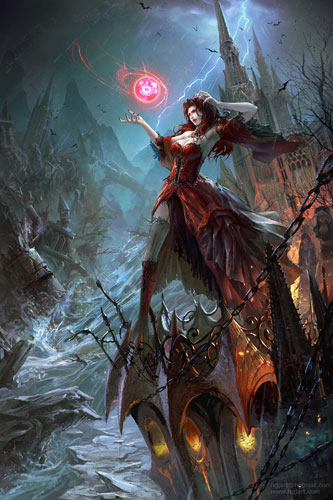
Frankly, I always imagined a witch rather like the two images below: a bent old woman, with a black cat, gathering herbs in the forest. A whizened crone in shabby, mis-matched clothes, flying around on her broomstick as if it was a Harley Davidson.
Self-sufficient, knowledgeable, not necessarily evil, but not someone who suffers fools. Someone whose knowledge and wisdom one could turn to in a pinch. Someone who could work some magic – who knows how to heal, as well as how to poison. Someone who flies around on a broomstick, and has fun doing it.
It is rather a different inner image than the vast majority of witch-themed art I have found on DeviantArt. I was hard put to assemble even half a blog post’s worth of images of *old* women. It seems like there is some unspoken ban on depicting the aged female.
I did, on the other hand, find an abundance of more or less scantily clad, wild-haired, baleful-staring, seductively curved *younger* women in red dresses (such as they were), in the vein of the image above (screaming loudly “look at me”, in a way the much more subtle image below does not, which in my eyes makes it a more accomplished and thought-out piece even though it is just a speed paint. Admittedly, you would probably pass it by in a crowded convention art show, which probably means it won’t sell for quite as much. Fortunately for the mental well-being of us artists, there are still people who like to look at art because they like it, for no rational, objective or scientific reason anyone has ever been able to discover in 5000 years of art criticism – not because they’ll be able to sell it for ten times the price on Ebay one day. Or because some art critic has stated that there is something wrong with their own taste and judgement. But, I digress).
— The scantily clad young women were the vast majority of images I found, even after filtering out all the naked air balloon boobs and stuff, of which I got a particularly ample serving when punching in the search term “witch”.


However, in this blog post I will stick to old woman witches – the witch of Grimm’s fairy tales, the old woman in the forest, the Baba Yaga and the Bruja. They might be classy aged hippies like the interpretation of the Russian Baba Yaga by a Brazilian artist, below. Or they might be genuinely horrifying, like the Mexican Bruja. Who may or may not owe her chicken’s foot to the house on chicken’s legs which is the home of the Russian Baba Yaga. It is all very cross-cultural, when it comes to witches!


The cackling old crone standing behind her greenly bubbling cauldron is another image that came up in a variety of permutations. If I remember correctly, something like it features in some famous Disney movie. Which is not so say that an artist cannot achieve a strong image by presenting their own version of an iconographic stereotype. Strangely enough, the image below makes the witch look almost male, more akin to the mad scientist, the “Madman in the basement”, rather than the “Madwoman in the attic”.

From there, it becomes ever more alien. While the next witch below is at least still identifiable as some kind of reasonably mature, humanoid female, the next one down is stripped of all human female attributes except the wild, snakelike hair. A cross between a tree stump and a dementor: is she a bogeywoman out to suck little children’s souls, or just a projection of their own fear and wild imagination?

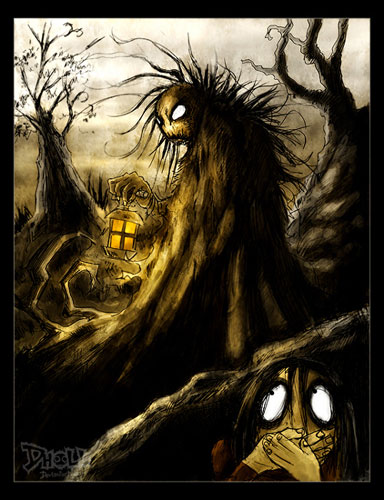
Not all witches are always out to suck a child’s soul – or fatten them up and eat them, like the Grimm’s witch did to Hansel. The witch never harmed Gretel, the girl child.
The Russian Baba Yaga is similarly ambiguous: on the one hand, she is a demented old hag flying around on her magic pestle, fearsome and vindictive. On the other hand, she does teach young Vasilisa the secret knowledge she needs to assert herself in an intolerable family situation, and eventually build her own life – based on a professional skill, not marriage to a fairytale prince (though she does eventually marry the czar).

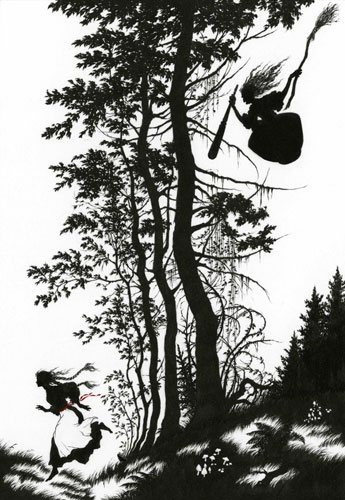
When it comes to “famous witches in literature”, Narnia’s White Witch will likely make the Top Ten (after Hermione Granger, and the witches of Oz). She represents another kind of witch: not the ancient crone who could not care less what anyone thinks of her, least of all her looks.
Narnia’s witch is a mature, even old, woman who pretends to be what she is not – young, beautiful according to the standards of a society which equates female beauty with sex appeal, and seductive. Even though in this case, her seduction involves Turkish sweets, rather than sexual favours!

In the story of Vasilisa the Beautiful – a variation on the “Cinderella” theme – the Baba Yaga fills the slot of the fairy godmother: an ally against the girl’s Evil Stepmother. In the story of Snow White, the witch *is* the Evil Stepmother. And again, she is an older woman obsessed with her looks. “Who is the most beautiful” is her most anxious concern, and she cannot tolerate the younger girl ‘s competition on that head.
In the original story, the stepmother “disguises herself as an old crone” when she brings Snow White the poisoned apple. In that respect, the illustration below is “incorrect”. But it points accurately at a deeper truth: unlike the Baba Yaga, who supports Vasilisa in developing her own skills, and being (economically, and otherwise) independent of men, Snow White’s stepmother can think of other (particularly, younger and prettier) women only in terms of competing for the favour and support of men – hence she sees them as the enemy, rather than someone they ought to nurture and support, like the Baba Yaga does.
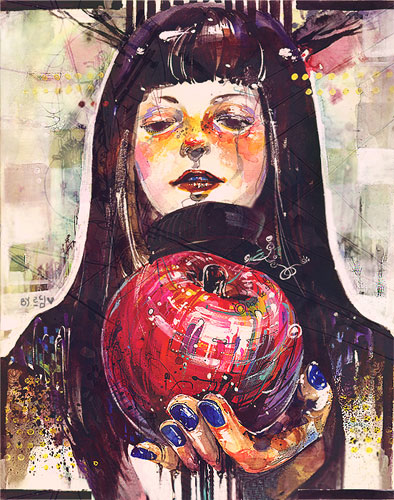
Finally, here is a personal interpretation of the Baba Yaga, this time by a Russian artist. This artist seems to conflate her with the Seductress – the Circe’s and Alcina’s of the mediterranean tradition, the old wrinkled, even skeletal women who make themselves appear young and seductive, and who turn their lovers into swine. Or stone. Or ice sculptures. In my next blog, I will look at some younger witches – so stay tuned, to see what I found there!
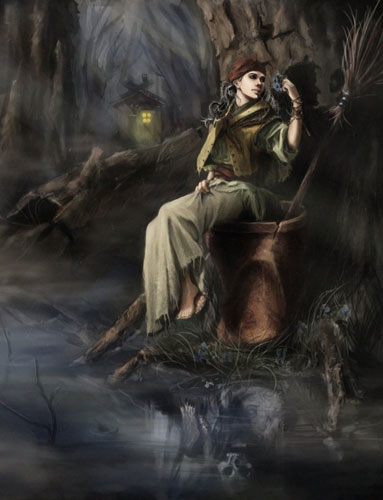
Images are copyright the respective artist, and may not be reproduced without their permission.











Note: The person these comments were addressed at, posted a self-promotional link to his own website in the original comment, accompanied by a short statement that gave me the impression that he had not even read the article. He then took offense when I stated the above opinions. Having received a lengthy rant in reply to my last comment, which was taking the discussion to a personal level, I advised him by personal message that in the interest of keeping the tone of the site polite, I would not approve any further comments of his on this blog. He asked for his original posts to be removed.
Not? Then how come you make a statement like this (I quote): “I know I’d much rather portray a beautiful young lady than an old hag”
If that isn’t condoning sexism, I don’t know what is. Does a woman have to be young to be beautiful? And is an old woman automatically a “hag”? And why would an old geezer be more aesthetically pleasing than an old hag? Maybe you should question some of your knee-jerk reactions on that head. Which is really what I want to achieve with this blog!
If you consider it a “nasty turn” if someone states a different opinion from your own, or has a different idea of beauty than your own, then alas I can’t help you.
I don’t think you are really interested in discussing the issue – your statements above crawl with ageism and preconceived notions of “beauty” which, I personally think, belong firmly in the white male supremacist rubbish bin of history, and if you choose to take personal offense at my stating a different opinion, then please consider not continuing this conversation.
I think what’s more interesting is that the wizard is practically *always* portrayed as an old man (long grey beard and all) and what’s more, there are *plenty* of images to be found – some of them even have pop culture icon status (e.g. Gandalf the Grey). The witch, on the other hand, is far more frequently portrayed as a younger, seductive woman – as I’ve said above in my article I found it hard to find even as many pictures of *old* witches as I have posted here, and they only make up about half of the collection.